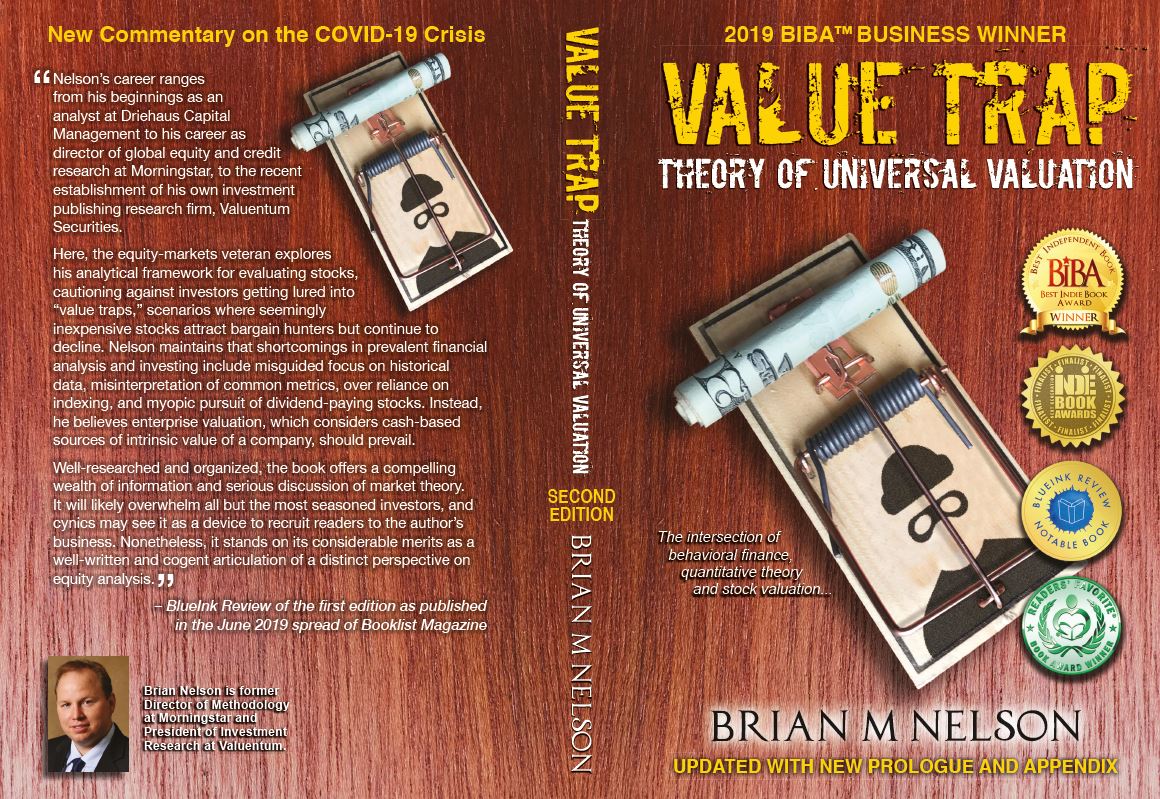Member LoginDividend CushionValue Trap |
Thinking Slow: 3 Research Blind Spots That Changed the Investment World
publication date: Oct 28, 2025
|
author/source: Brian Nelson, CFA
 Dear members:
---Daniel Kahneman in his text Thinking, Fast and Slow (1) divided the human psyche into two systems. The first system is instinctive and emotional, often set on autopilot, while the second system is slower and more logical, requiring a calculating conscious. Many of the maxims the investment world takes for granted today suffer from conclusions that are made rapidly, almost without thinking, driven by our first system, creating what I call research blind spots.
---
In World War II, Allied bombing raids were suffering from very high casualty rates. It was estimated that for those pilots that were flying at the beginning of the war, only about 10% survived, a terrible loss rate. Bombing was crucial to the Allied effort, however, so high command sought to cut the number of casualties with a focus on where to put the armor on the bomber. But where should they put it? One couldn't arm the entire bomber as it would be too heavy to take off (2).
---
They studied the planes that came back from their missions and found that there were concentrations in bullet holes on the fuselage, wings and the tail. Instinctively, it seemed obvious that to reduce casualties, one should arm these heavily damaged areas. However, what was missing was the data on the planes that hadn't returned. It turned out that the areas that actually needed to be heavily armed were the cockpit and engines. The planes that sustained damage in these areas never made it back.
---
These types of biases, or research blind spots, as I call them, are everywhere in finance, and there in the most common places--sometimes with respect to your most treasured beliefs. For the researcher, it's very hard to see them, much like a driver can't see a blind spot on the road, but it's so very important to be aware of them. As I was writing my book Value Trap, I often wondered how so many investors could miss so many obvious things, but it turns out, biases and blind spots are more common than I believed. Let's talk about three that I discuss in Value Trap (3).
---
1) Research Blind Spot #1: Active Management and Missing Data
 Image: Active domestic equity mutual funds and ETFs represent just 15% of the stock market, hardly enough data to make any conclusions about the merits of individual stock selection. Source: ICI.
---
In the widely publicized active versus passive debate, many from Jack Bogle to Burton Malkiel to prominent index fund licensers have studied the performance of professional active fund managers. The takeaway goes that after fees, many active fund managers don't perform all that well. But just like in the Allied bomber example, their work only covers a part of the market where the data is abundant, similar to concluding that armor should be placed on the fuselage, wings and tail given the evidence on planes that returned.
---
The stock market, however, is much bigger than professional active management, and in fact, when professional active management underperforms, another part of the 70% of the stock market actually outperforms (e.g. the individual investor, hedge funds, pension funds, life insurance companies, etc.). With our mental research systems on autopilot, however, popular studies defer to incomplete data sets to defend the efficient markets hypothesis, creating research blind spots completely overlooking a part of the market that's nearly 5 times bigger than professional active management--or what one might say, the critical data on the planes that didn't return.
---
Our biases lead us to believe one thing almost unconsciously, but we must be aware that our brains are wired for autopilot, unless we truly challenge assumptions and parameters and "think slow." For example, instead of asking what percentage of the market these studies cover, finance has hastily jumped to conclusions on incomplete data to support a bias. Studies on just 15% of the stock market tell us next to nothing about the merits of stock selection, but this research blind spot has changed the investment world. Indexing and passive management continue to proliferate.
---
Research Blind Spot #2: ETFs and the Wrong Construct
---
In the physical world, we take for granted empirical and evidence-based analysis. Studies in chemistry, medicine and beyond provide answers to questions that we knew next to nothing just a few decades ago. Our brains therefore have become hardwired to trust data, any data, as a result.
---
However, this isn't always a good thing in the world of investments. Perhaps one of the best-selling books to read is Darrell Huff's 1954 classic, "How to Lie with Statistics," which explains the hazards of confusing correlation with causation. Yet, like the Sirens in Greek mythology, investors are lured to more and more data.
---
The field of finance took a turn toward empirical work sometime in the 1960s as computers (and data) became more widely available for number crunching. With more and more data, the field arrived at more and more "conclusions," paying little mind to the actual construct of the market, which is based on future expectations. Here is a quote from Peter L. Bernstein's Capital Ideas Evolving (4):
---
Sharpe is concerned that too many practitioners--and a large number of the business school professors from whom they learned their trade--tend to forget that all asset pricing models are about expectations. And how in the world can you measure expectations, which are a look forward, not backward? You cannot just look at history and deduce much about what expectations have been--or will be. The whole matter revolves around the future. Therefore, the historical data on which we all depend so heavily may be useless for asset pricing. As we never know with certainty what the future holds, all we have to rely on is a sense of the probabilities of future events.
---
"You are just reduced to a religious statement," Sharpe concludes. "I have been around long enough to see empirical results that seem to be really solid until you try a different country or different statistical method or different time period. Maybe that's why Fischer Black said you should put your trust only in logic and theory and forget about statistical empirical results."
---
What Bernstein and Sharpe indicate in this excerpt is that empirical, evidence-based analysis using realized data may tell us little about the stock market, asset pricing, or much of anything. The market, itself, is a function of future expectations, and some of the "conclusions" we hold dear based on realized data may very well be wrong. There may be nothing wrong with the data and analysis, but everything wrong with the construct.
---
Empirical researchers, when using realized data, suffer from a research blind spot, or a bias for realized data. They hastily use it in developing new products without "thinking slow" about whether such data makes sense or not. Backtesting and data mining of realized data have nonetheless changed the investment world, fueling the big business of ETF fees, despite The Smart Beta Mirage (July 2020):
---
We document sharp performance deterioration of smart beta indexes after the corresponding smart beta ETFs are listed for investments. Adjusted by aggregate market return, the average return of smart beta indexes drops from 2.77% per year "on paper" before ETF listing to −0.44% per year after ETF listing. This performance deterioration cannot be explained by strategic timing in ETF listing nor explained by time trend in factor premia. We find evidence of data mining in constructing smart beta indexes as the post-ETF-listing performance decline is much sharper for indexes that are more susceptible to data mining in backtests. Our results caution the risk of data mining in the proliferation of ETF offerings as investors respond strongly to the stellar performance in backtests.
---
Research Blind Spot #3: Multiples and Short Cuts
---
Our brains are hard-wired for short cuts.
---
There are helpful short cuts like the Rule of 72 as it relates to how long it takes to double one's money given an annual rate of return, and good rules of thumb for how much one should save for an emergency fund or what percentage of your gross income should be devoted to housing expenses, but there are also harmful short cuts. With our brains on autopilot, we might think a stock that is trading at 10x earnings is more attractive than another stock trading at 20x earnings.
---
We hastily jumped to this conclusion without "thinking slow" about what is implied by those multiples. For example, the stock trading at 10x earnings might truly be overvalued, sporting the characteristics of a value trap with a huge net debt position, while the stock trading at 20x earnings might have a tremendous net cash position and huge free cash flow prospects that are undervalued by the market. Only through the process of enterprise valuation (i.e. the discounted cash flow method) can one understand those multiples and what they imply with respect to a firm's valuation.
---
Humans' bias for short cuts has resulted in the behavior of preferring low-multiple entities regardless of their underlying characteristics. Furthermore, we support this bias with decades of backward-looking data, but it's likely what we're looking at with many studies is nothing more than randomness. Even with statistical evidence now suggesting that the "value" factor has not held up in walk forward studies, by Fama and French, themselves, investors cannot overcome their bias toward short cut evidence-based analysis supported by backward-looking data mining efforts. Factor investing, nonetheless, continues to change the investment world.
---
Concluding Thoughts
---
We have to be on high alert about how our minds work. PBS recently delivered a four-part series examining about how easily our minds are being hacked, and why it is so important to "think slow." Tune in (5). When it comes to the active versus passive debate, does the analysis suffer from parameter risk? With respect to empirical, evidence-based analysis, does the analysis have the entire construct wrong? When it comes to short-cut multiples, are we falling into the behavioral trap of thinking on autopilot? I hope that you found this article helpful, and don't let your mind get hacked!
---
------
Kind regards,
---
Brian Nelson, CFA
President, Investment Research
Valuentum Securities, Inc.
brian@valuentum.com
---
It's Here!
The Second Edition of Value Trap! Order today!
 -----
---
Tickerized for holdings in the SPY. This article was originally published on September 11, 2020.
---
Brian Nelson owns shares in SPY, SCHG, QQQ, DIA, VOT, BITO, RSP, and IWM. Valuentum owns SPY, SCHG, QQQ, VOO, and DIA. Brian Nelson's household owns shares in HON, DIS, HAS, NKE, DIA, RSP, SCHG, QQQ, and VOO. Some of the other securities written about in this article may be included in Valuentum's simulated newsletter portfolios. Contact Valuentum for more information about its editorial policies. Valuentum members have access to our 16-page stock reports, Valuentum Buying Index ratings, Dividend Cushion ratios, fair value estimates and ranges, dividend reports and more. Not a member? Subscribe today. The first 14 days are free. |


2 Comments Posted Leave a comment